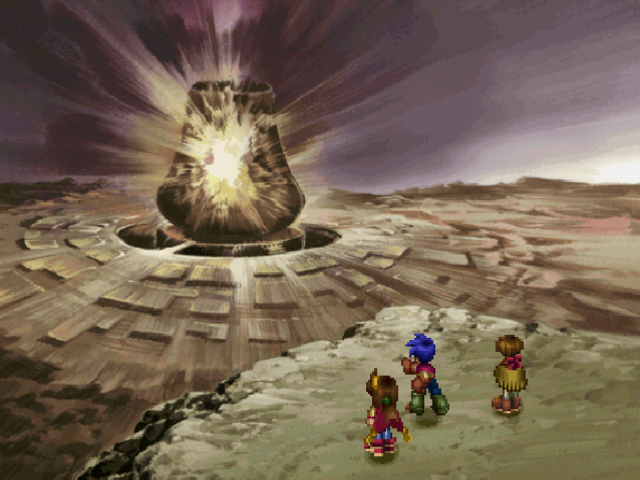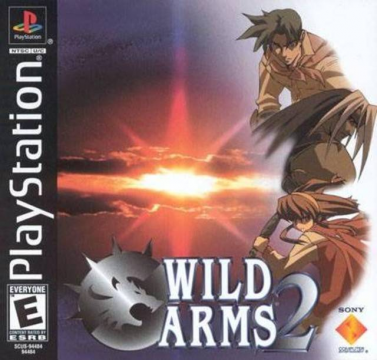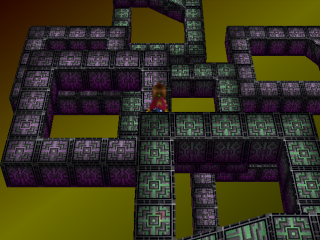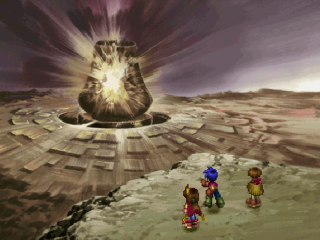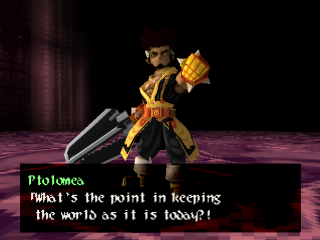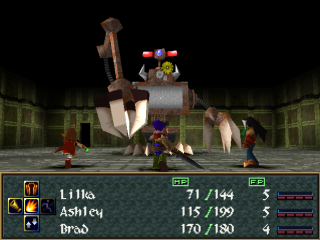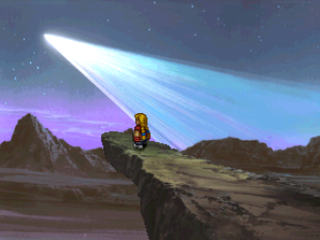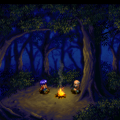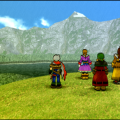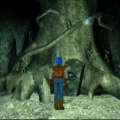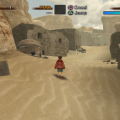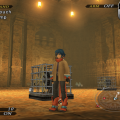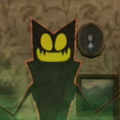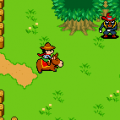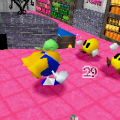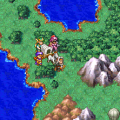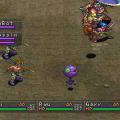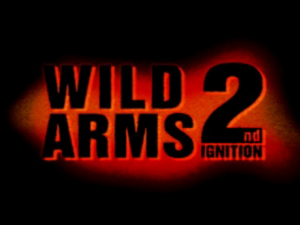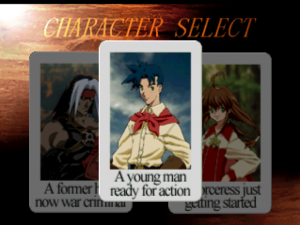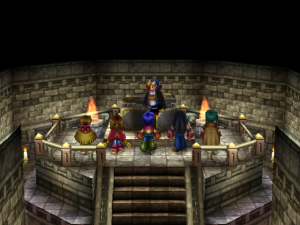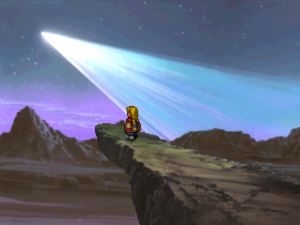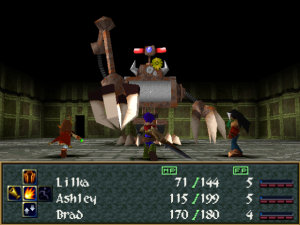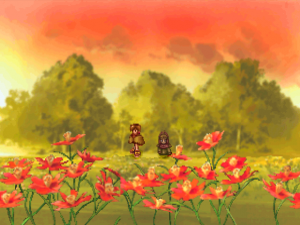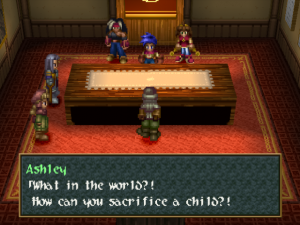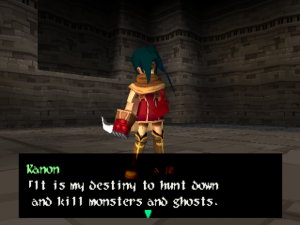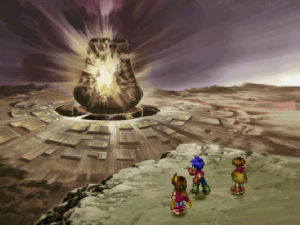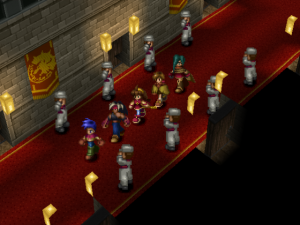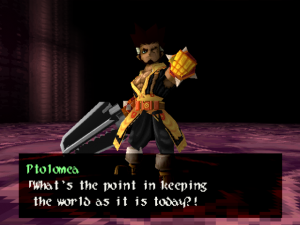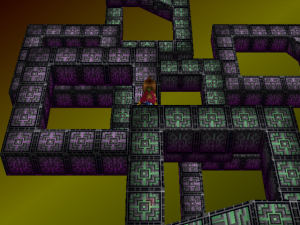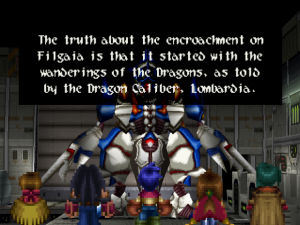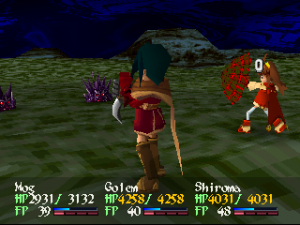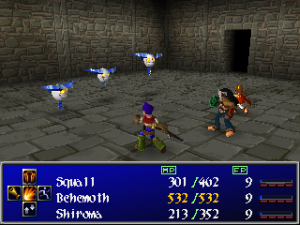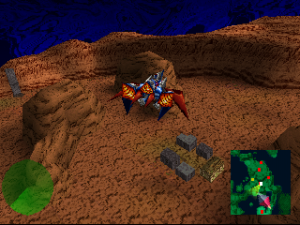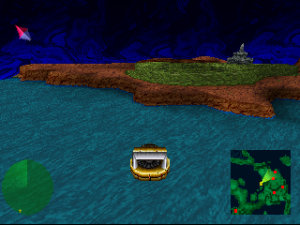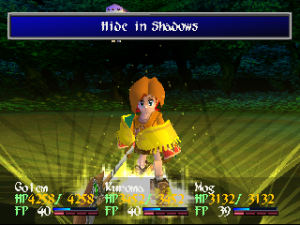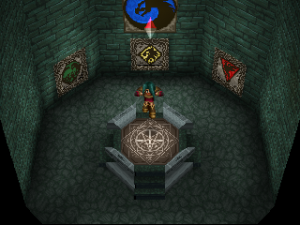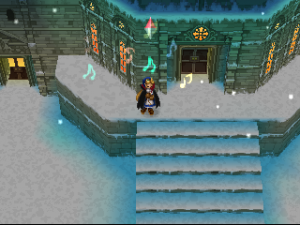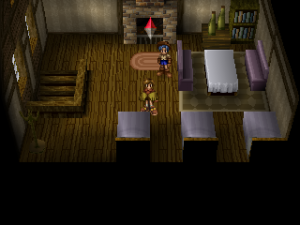Wild Arms 2 is the series’ black sheep. In some ways it doesn’t deserve to be—its plot is actually one of the most mature and ambitious of the lot—but unfortunately it suffers from an abysmal translation that renders the narrative confused, at times even totally incomprehensible, and the pacing is poor. There are a few diamonds in the rough here, but unless you really want to play through the whole series, or there’s something that interests you about it, Wild ARMs 2 is best skipped over. Which is such a shame, because when you look closer there was so much potential, containing daring and complex themes that would give Yoko Taro a run for his money.
The narrative concerns a ragtag team called ARMS (Agile Remote Missions Squad) taking down a terrorist organization named Odessa. Odessa’s ambition is a hostile takeover of power in Filgaia, which is again in a state of ecological devastation (also giving off more steampunk vibes this time around). Our three primary protagonists are recruited by a mysterious man named Irving Valeria to be the first members of this anti-terrorist task force.
Characters
Ashley Winchester
A young military recruit who gets possessed by the spirit of an ancient evil being called Lord Blaze.
Lilka Eleniak
A crest sorceress with an inferiority complex.
Brad Evans
A war hero turned war criminal for dubious reasons.
Three more characters join the party later.
Tim Rhymeless
A twelve-year-old Baskar boy who can channel Guardians, the elemental spirits of Filgaia.
Kanon
A cyborg who seeks to kill the spirit possessing Ashley.
Marivel Armitage
A secret character who seems to know Ashley from long ago.
One of the main issues with the story starting out is its lack of urgency. Simply, for the most part Odessa’s evil deeds feel so ambiguous and out-of-sight that we’re not sure what we’re fighting against. For comparison, in the original game the demons destroy a kingdom right off the bat. We immediately see how dangerous they are. Odessa does show some of their destructive impulses, but the way the plot lays it out fails to communicate dire stakes. The routine for the most part is visiting Valeria Chateau (the main HQ), getting a mission from Irving, going out and completing that mission, then repeating the process. There’s no build-up. And when the inevitable mid-game villain switch-up (another signature of the series) occurs, we’re given a more direct threat of destruction but an even more nebulous antagonist. This wishy-washy approach to antagonists may be the result of the games’ wanting to deal with themes of moral ambiguity, as the question of whether or not Odessa is technically completely wrong is always up in the air. But either the translation or the original writing itself isn’t strong enough to make that question compelling to play through.
Still, within the boring story there are some genuinely interesting themes. Heroism as a concept is explored in particular. Every character struggles in some way with their concept of how to be a hero, especially Ashley. Rather than working through a typical Joseph Campbell Hero’s Journey, Wild Arms 2 subverts the idea that individuals make history through solitary actions and sacrifices, and emphasizes instead that heroism is actually a communal effort, that often heroic actions are done out of necessity or accident rather than bravely and purposefully. It is captivating content that might be better portrayed in the Japanese. In English it’s hard to get past the garbled translation. The writing, to be fair, does tend to be verbose and purple, so localization must not have been an easy task. But still, a game this reliant on its dialogue shouldn’t fail so spectacularly in making sense. The worst offender is a character named Liz (with his sidekick Ard), who speaks in references to Japanese pop culture, which are translated literally, resulting in straight-up gibberish.
Sexuality plays a part in the character arcs as well, if a small one that has to be referenced indirectly. Still, it’s a bold choice of subject for a game even now. Ashley and his girlfriend Marina actually have sex in-game, implicit in a pretty obvious line of dialogue about Marina “showing affection through her body”. There is also an androgynous villain named Caina who is male in the Japanese but female in the English-language version because he shows romantic feelings for Vinsfeld, Odessa’s leader (though hilariously he’s still referred to as male in the first disc of the English release, the pronouns change in the second when the gay subtext is made text). Irving and his sister Altacia are also strongly implied to be in an extremely creepy incestuous relationship.
Most significant though is Brad, a character commonly believed to be gay. While homophobic gamers have denied this, it seems pretty unambiguous if you look at it for two seconds. Toward the end of the game, for example, if you find three secret items in a dungeon called the Sacrificial Altar, you can talk to certain characters to get the most powerful mediums. Two of these characters are Ashley and Tim’s female love interests. The third is Brad’s old war buddy Billy. That doesn’t feel unintentional to place him alongside those love interests., especially when considering Brad’s vignette in the ending sequence. At worst you could say Brad wasn’t written with sexuality in mind at all, so you can’t say he’s heterosexual either. But at the same time, c’mon! The writing is on the wall.
Wild Arms 2 introduces a few new gameplay mechanics. Some good, some bad. The most egregious is how world map navigation is now treated. Instead of new locations simply being on the map, you have to send out a radar signal to “reveal” new locations. Which means that new locations won’t appear on the map until you find them, and often even if you’re at the right position you won’t be able to reveal the new location until you’ve received information about it elsewhere. Navigation in this game isn’t as bad as it will be in Wild Arms 3, but the only evident reason for this approach to navigation is to pad out the game length by giving the player a few more hoops to jump through. There’s just no reason for it. You can also use the signal to locate hidden items and optional locations, and it should have just been used for those purposes. Graciously, one of Kanon’s tools is a radar that shows the approximate location of where new areas are on the world map. Navigating is still kind of a pain, and it’s pretty far into the game besides, but it’s better than nothing.
Another mechanic is more useful: the option to cancel battles before they occur. For most random encounters, a white exclamation point will appear over the player character’s head. If you press O in time the battle will be canceled. Build up too many of these however and you’ll get more red exclamation points, which are unavoidable encounters. There are also green exclamation points, indicating weaker foes. This, as mentioned in the previous article, is a welcome addition to the gameplay, as it helps alleviate getting into battles when you’re trying to solve a puzzle.
Wild Arms 2 also sets the precedent of there being no buyable healing items, at least until the very end of the game when you can access a secret shop that sells them. You have to find Heal Berries out in the world and ration them. Resource management is made more integral to the gameplay in Wild Arms 3, but here it’s mostly more artificial difficulty. In practice it mostly means that you do your healing in-battle.
You can’t use healing spells out of battle anymore either since MP has been eliminated. As mentioned previously, Arms games after the original mix MP and FP together. FP is now correlated to one’s level, meaning you start out with as much FP as your level. After level 25 then, you have access to your first force ability right off the bat. FP isn’t used up when you use magic, so the challenge is instead in getting up to the required amount of FP and maintaining it. One may, for example, have Lilka use a force ability like Mystic, lose all her FP, but then realize they need to use a healing spell the next round and can’t. Battles then become a matter of balancing the amount of FP you have on hand. Luckily, FP still increases when you are attacked or when someone attacks you, and it still increases relatively quickly.
Ashley and Brad both use ARMs, and the way they upgrade is the same as Rudy’s. The difference this time is that you can only upgrade each ARM ten times, so you have to be strategic about how powerful and accurate your guns are, as well as how many times you can use them. Lilka uses the Crest Grid, and it works identically to Cecilia’s. Tim gets his magic from Guardian mediums. He needs to equip a medium and defeat a certain amount of enemies to gain their skills. Kanon’s abilities are similar to Jack’s Quick Draw. She is a cyborg with forgotten powers, so her skills are technically “remembered” by using her other skills repeatedly. The likelihood of her remembering skills is dependent on luck. It’s again similar to the glimmer system of the SaGa games. Mariel basically uses blue magic, gaining skills by absorbing them from certain enemies. She has a lot of useful skills, but if you’re working without a guide it can be a pain to figure out how to get them.
Comparisons to Xenogears are hard to deny. The graphics are uncannily similar, sprites set against fully rotational 3D backgrounds, the only difference being you can’t jump in Arms (sans specific puzzle areas tied to one of Kanon’s tools). The settings are both desertified and war-torn. The Sword Magess of Arms‘ lore parallels Xenogears‘ Sophia in terms of tragic background martyrs. Ashley is possessed by Lord Blazer in a way similar to Fei Fong Wong’s relationship to Id. Likely this is due to the themes that were popular in manga/anime at the time, work like Trigun and Neon Genesis Evangelion that discuss concepts of heroism, sacrifice, and doing what’s right, as well as making out of left field Gnostic/religious references.
Michiko Naruke’s soundtrack is wonderful as always. The theme music “You’ll Never Be Alone, No Matter Where You Go” is a catchy, brass-focused tune, much in line with the music copped from westerns in the original. The world map music “The Barren Lands” is another whimsical, whistleable melody. The tracks here don’t appear to be as transparently lifted from western scores as the original, though be sure to let us know if anyone notices any.
Unfortunately the sidequests in the sequel simply aren’t as good. There are more of them, but there’s less incentive aside from level-grinding to pursue them. Aside from the quests connected to Mariel, for the most part they are random bosses that aren’t tied to the story in much any way. There’s just not as much satisfaction in doing them as there was in the original. Interestingly, there is a boss who’s even more difficult than Ragu O Ragula: Angolmois. Doesn’t really mean much though, except that there’s at least a use for the Sheriff’s Star.
If the original Wild ARMs is standard JRPG par excellence, Wild Arms 2 is an example of that slice of the genre that tried to experiment and didn’t quite work out. It’s not the worst ever, it’s not unplayable or anything. And, to be fair, a lot of its flaws for an English-language player come down to the horrible translation. But Wild Arms 2 had ambition perhaps beyond what it was capable of actually conveying, and it shows. It wants to be something postmodern and complex, subversive and dynamic in a way it just never shows itself being. With more polish and with a better translation, Wild Arms 2 might be looked back at as fondly as we look at Xenogears. The way it is now though, it’s just something to play out of curiosity.
